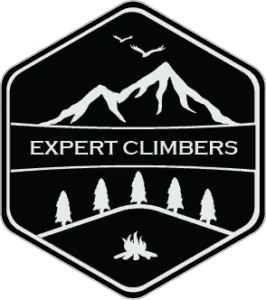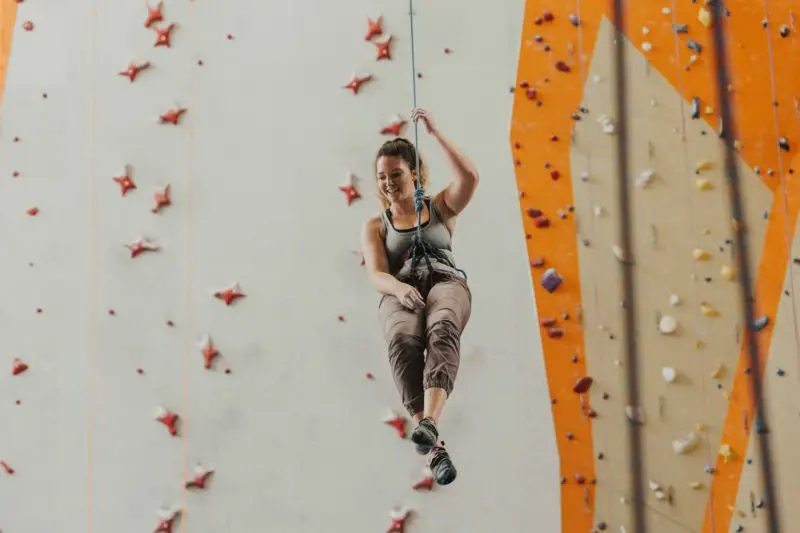Bouldering is becoming increasingly popular. Also considered “indoor rock climbing,” bouldering walls are now introduced at local gyms and special facilities dedicated to bouldering are popping up everywhere. What makes bouldering so enticing is the fact that it’s easier than rock climbing. You can climb at a lower height (you can also do it on smaller rock formations in nature called boulders) and without the use of harnesses and ropes. While you still need a decent amount of upper-body strength and stamina, you don’t need to be some overly fit expert to try it out.
Both beginners and experts can climb together and finding the right climbing route for your skill level is easy. Just look for “holds” (which are resin protrusions) that are colored for your preferred degree of difficulty. Expert climbers will choose the more difficult route, allowing you to climb alongside them and learn from them at the same time. The full-body workout is a great way to get in shape and can be a great stress reliever! Bouldering is also great for giving your brain a quick workout since it requires you to plan your movement while constantly adapting as your body gets new information about its surroundings. The course a climber takes from the bottom to the top of the wall is considered a “problem, “ so the entire act of bouldering is an activity that requires problem-solving.
If you’re ready to try your hand at bouldering, here are a few essentials you’ll need:
Climbing Pants
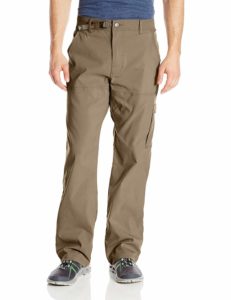
Climbing requires you to stretch out your body in various poses as you climb to the top of the wall. Because you’re constantly on the move, you’ll want to wear something comfortable when bouldering. Climbing pants are ideal because they’re made from durable, stretchy fabric that will easily move with you. Climber’s pants also feature a roll-up pant leg that you can secure with a snap closure so that you don’t step on them while climbing. The best climber’s pants are the ones that are ideal for climbing and everyday life, allowing you function and style every day.
Although you don’t necessarily need to wear climber’s pants while bouldering, they do help since they’ll protect your knees and legs from getting scratched. After spending months looking for the best climbing pants, I found these by prAna (amazon link) to be the best; they’re abrasion resistant so that they won’t get damaged from rubbing on the wall or rock surface. A drawstring, elastic waistband is preferred so that the waistband doesn’t dig into your stomach as you’re climbing.
T-shirt
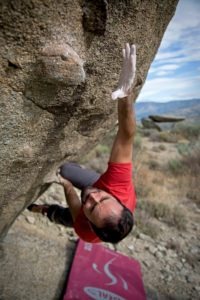
Similar to climber’s pants, you’ll need a comfortable T-shirt for bouldering. When choosing a climbing T-shirt, look for something that allows you the freedom to move. Your arms need to move unrestricted during your climb, so you don’t want a T-shirt that will decrease your range of motion. If it’s cold, a loose-fitting long-sleeve shirt like this one by Naviski will keep you warm as you climb, especially if you’re doing it outdoors, I love it! It’s extremely comfortable, lightweight and even protects my skin from UV radiation, so I can finally get rid of my sunscreen!
Also, you’ll want to consider the materials of the T-shirt since the abrasive surfaces of the climbing wall can damage your shirt. Cotton shirts will hold up better than a T-shirt made with Techwick.
Climbing shoes
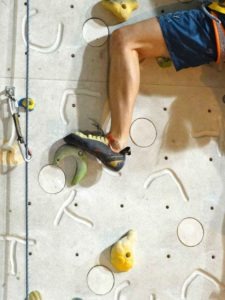
You’ll need a good pair of climbing shoes when you first start bouldering. The technical nature of bouldering requires more specialized shoes, and the wrong ones will make your bouldering experience harder. Look for a shoe that features a slip-lasted manufacturing technique, which is a sole with thin rubber. This allows climbers to have a sensitive feel on the rock or wall that they’re climbing. You might also want to consider a Velcro-closing option that makes taking them off easier in between climbing sessions. Also, make sure that the shoe you choose is comfortable. An uncomfortable shoe will make climbing a miserable experience.
Size is important in climbing shoes. A looser shoe will be more comfortable, while a tighter one will perform better, so finding a balance is key. Never choose a shoe that is painful when you first try it on since it’ll be painful when you climb. But if they’re too comfortable, you run the risk of them being too big. Although they feel great right now, once you climb in them, you’ll realize that there’s too much room in the shoe.
The shape of the shoe will also affect the performance and comfort of it. Flat or neutral shoes are more comfortable and better at smearing. But downturned shoes sill give you the most power for steep climbing and edging.
Check out my post on climbing shoes to learn more.
Climbing Chalk
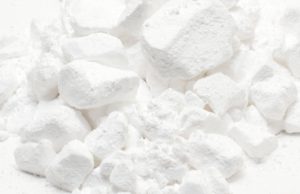
You’ll always want chalk in your climbing arsenal since it keeps your hands dry and keeps you from sweating off of any holds. There are three different chalk forms available, and each climber will need to figure out which one is best for them. Loose chalk will completely coat your fingers and palms. Chalk balls are fine-grain chalk wrapped in a fabric sock, while chalk blocks are solid pieces of chalk.
If you care about neatness, chalk balls are better than loose chalk. They also provide a finer coating on your hands. But block chalk is also a great option since you can easily store it in your bag and then crush it down into a powder with your desired consistency.
Some chalks utilize a chemical drying agent that will keep your hands dry and prevent sweating from having the chalk come off (these are typically more expensive). You’ll need to experiment with different chalks to find one that you like best.
If you want to learn more about climbing chalk check out this post.
Oh! And don’t forget proper chalk etiquette among climbers. Brush off the holds when you’re finished and if you drop someone else’s chalk on the ground, clean it up!
Chalk Bag
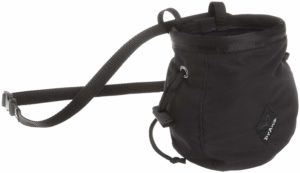
Now that you have your favorite chalk, you’ll need to store it somewhere. A chalk bag is specifically made for holding your chalk. These bags are available in different shapes and sizes, so you’ll be able to personalize your bag to fit your preference. When looking for the perfect chalk bag, find one with a wide opening and a deep pouch like this one by prAna. This way you’ll be able to get your hands in the bag easily. Other features to look for in a bag include a waist belt to wear while climbing, a closure system so that the chalk doesn’t spill onto everything in the bag and a storage pocket to add in other small items.
Bouldering Brush
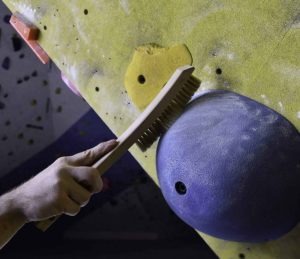
As numerous climbers use the same holds over and over again, chalk, dirt, and grime start to buildup on the holds, making it difficult to get a good grip. Plus, touching it is sort of gross when you think about someone else’s sweat being on the hold, too! And if you’re climbing outdoors, you also have to worry about precipitation and sappage (which is seepage of groundwater through the fractures, cracks, and jointing) making a mess on the holds. When you see a hold that’s dirty and in this gross state, be courteous to other climbers and use a brush to clean it and make their lives a little bit easier at the same time. You’ll be doing yourself and other climbers a huge favor!
There are a variety of brush types to choose from, including steel, nylon, and horse/boar hair options. If you use a steel brush, make sure that you’re gentle with the holding (especially if you’re climbing outdoors since it can destroy softer rock). The best climbing brushes are horse/boar since they don’t damage the rock click here to see their prices on Amazon, hold their shape, are easy to use and will absorb oil and dirt. When searching for the best climbing brush, look for one that will clean chalk and crud off holds without damaging the texture. They should also be ideal for both indoor and outdoor use. Other key features to look for in a quality climbing brush include: longer bristles, ergonomic design to make cleaning holds easier and will easily fit in chalk bag loops.
Athletic Tape
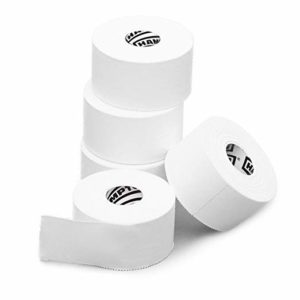
Experienced climbers swear by tape since it provides them skin protection and structural support. Athletic tape creates a layer of protection to prevent the skin on your fingers from ripping as you climb, which is especially helpful for outdoor climbers, check out our skin care guide to learn more. An extra layer of tape can help save you from an injury that can potentially take a few days to heal, putting you out of climbing commission. Adding tape for structural support can possibly provide support for an injured pulley (though the best healing method is rest).
But no matter what you’ll use it for, you’ll want to get the correct tape. Not just any athletic tape will do. For climbing, the tape shouldn’t stretch and should be very sticky. It should also be able to rip into long, thin strips to use on your fingers. If you’ve played other sports in the past or used athletic tape to wrap a twisted ankle, you already know how some tapes are really stretchy and how it sticks to itself instead of your skin. That’s exactly what you don’t want to happen when you’re climbing. But since everybody has different preferences and bodies, you’ll want to try out a few different choices to see what tape works best for your individual needs; check out my skin care guide to learn more.
Bouldering Crash Pad
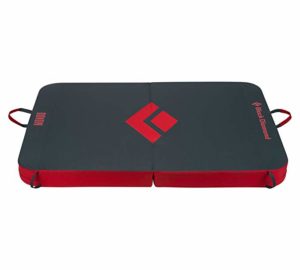
If you prefer outdoor climbing, you’ll definitely want to invest in a crash pad. A crash pad is placed right below a problem just in case you fall. Since bouldering is all about pushing yourself and perfecting hard moves, the chances of you falling are high. As the only climbing discipline that requires ground falls, you’ll need something soft to land on or else you risk getting severely injured. Injuries like bruised hells, broken legs, sprained ankles, and wrenched knees are common while bouldering. A thick crash pad like this one by Black Diamond is important when bouldering so that it helps break your fall. With a bouldering crash pad in place, you’ll know exactly how to position your body so that you can propel yourself off the rock in the right direction.
There are plenty of options when it comes to crash pads, but the biggest differences are the foam they use inside the pad and how they fold into a backpack (folding in either a hinge, taco or baffled style). Although it might look like all pads use similar foam inside, the truth is that they don’t. Each manufacturer uses foam based on three different factors: foam type, composition, and thickness. The foam type can either be closed cell, open cell or memory foam. Composition depends on how many layers of foam they use, while thickness can range from 3.5” for medium sized pads to 4” to 5” for larger ones. A thicker, stiffer foam pad will generally last longer and is best for big falls since you reduce the chances of bottoming out when falling on the pad.
A taco-style pad features a continuous piece of foam that folds in the middle upwards to make a taco shape. However, it doesn’t fold flat to store, which can be a problem for some. A hinge-style pad features a crease in the middle that connects two foams together. This style does lay flat to store, but the downside is that the hinge could fail. The baffled style is fairly new in the industry and features many partial hinges that come together to form several tube-like baffles. It’s actually heavier than other pads, but it does fold flat. On even and flat surface, hinge-style pads are better because they can lay flat. But their flaw on uneven rock surfaces is that if the hinge lines up with a pointy part of the rock, it won’t cover it, so there’s a chance your fall can still be dangerous if you come down on that point.
The Right Mindset
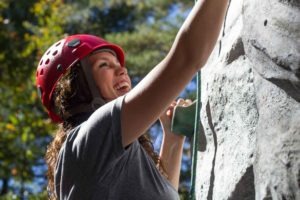
Another essential that you can’t buy in stores is the right mindset. Mental training is important when you want to take your bouldering skills to the next level. If you want to succeed as a climber, you’ll need the mental strength to do so despite how strong or willing your body is. If you’re not in the right mindset during climbs, you won’t reach your maximum potential. Visualizing your success throughout your day can help when you’re physically climbing. It’s a sort of practice for what you want to achieve. You’ll want to first think about your climbing and analyze any areas where you think you can improve. Reflect on your climbing and work to pinpoint the things that can help you become a better climber. Then, practice the things you want to work on during warm-up drills or during easy routes. When you’re ready, practice them on new, challenging routes!
When you’re equipped with the right essentials, you’re setting yourself up for success for all of your bouldering adventures, regardless of whether you prefer indoor or outdoor bouldering.
